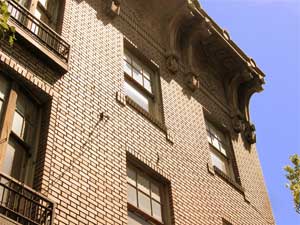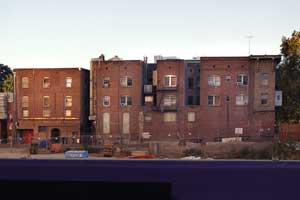A Last Look at the Bel-Vue?
Posted on August 22, 2009 – 3:30 PM | by OldManFosterBy Bill Burg
The Bel-Vue Apartment Building, located at 809 L Street, is an understated and long-neglected landmark that faces demolition in the near future. Some of Sacramento’s architectural landmarks are obvious, based on their prominent role in history, association with well-known individuals, or architectural grandeur and scale. Sometimes, buildings become landmarks because of their association with ordinary people, and simply avoided demolition long enough to be recognized as historic. The Bel-Vue, originally known as the American Cash Apartments, is a building of the latter sort. Despite its landmark status, it faces demolition by its owner, the city of Sacramento.
Constructed in 1910 as the American Cash Apartments, the Bel-Vue is a subtly decorated brick apartment building featuring elements of Craftsman architecture. Simpler and less gaudy than the commercial buildings of the earlier Victorian era, the Bel-Vue also represented a newer style of housing in American cities. Unlike boarding houses and residential hotels, efficiency apartments like the Bel-Vue were self-contained units. Boarding houses shared bathroom and kitchen space, with minimal privacy. Hotels prohibited cooking in rooms for fire safety, a rule residents often broke by attaching crude stoves to hotel gas or electric lines. With their own bathroom and kitchen, apartments provided privacy and convenience to the urban professional of 1910 while retaining proximity to downtown workplaces and amenities. For single adults or new families not ready (or willing) to move to the suburbs, urban apartments were popular downtown homes. The Bel-Vue was one of the many apartment buildings, residential hotels and boarding houses found in downtown Sacramento.
 Today, the Bel-Vue would be considered mixed-use, middle-income residential housing with ground floor retail. The American Cash Store grocery store and the James Hayes meat market were the original retail tenants. Later businesses included the Muzio Bakery and the Fort Sutter Stamp Company. The earlier “American Cash Apartments” name was replaced by “Bel-Vue” about 1940. As downtown Sacramento’s fortunes slid after World War II, middle-class tenants moved to apartments or homes in Sacramento’s suburbs, and the demolition of Sacramento’s waterfront hotels and boarding houses moved their transient population east into the Bel-Vue’s neighborhood. Hotels like the Clunie, Berry and Marshall became housing of last resort for thousands of people. The Bel-Vue’s amenities meant it was never considered in the same category as SRO (single room occupancy) hotels, but it inevitably became part of Sacramento’s new SRO neighborhood. Owned by landlords more interested in quick rent than the building’s appearance and located in disreputable neighborhoods, apartments like the Bel-Vue lost much of their appeal despite their architectural beauty.
Today, the Bel-Vue would be considered mixed-use, middle-income residential housing with ground floor retail. The American Cash Store grocery store and the James Hayes meat market were the original retail tenants. Later businesses included the Muzio Bakery and the Fort Sutter Stamp Company. The earlier “American Cash Apartments” name was replaced by “Bel-Vue” about 1940. As downtown Sacramento’s fortunes slid after World War II, middle-class tenants moved to apartments or homes in Sacramento’s suburbs, and the demolition of Sacramento’s waterfront hotels and boarding houses moved their transient population east into the Bel-Vue’s neighborhood. Hotels like the Clunie, Berry and Marshall became housing of last resort for thousands of people. The Bel-Vue’s amenities meant it was never considered in the same category as SRO (single room occupancy) hotels, but it inevitably became part of Sacramento’s new SRO neighborhood. Owned by landlords more interested in quick rent than the building’s appearance and located in disreputable neighborhoods, apartments like the Bel-Vue lost much of their appeal despite their architectural beauty.
As the forces of urban renewal and redevelopment marched east along K Street, many buildings were heavily modified or demolished, and some found new roles. The Feldhusen Building on the corner of 8th and L, originally built in 1895, was remodeled in 1954 with blue-green vitriolite panels, destroying the building’s historic appearance. Around the corner at 815 L Street is a 1915 building that was remodeled in 1958 and became the second location of Sam’s Hof Brau. The building still bears the Sam’s logo in stained glass on its windows and doors, and a Sam’s sign is still painted on a rear wall of the building. Due to sheer chance- or the unwillingness of the building’s owners to pay for a remodel- the Bel-Vue never received a facelift. Its architectural integrity and understated beauty led the Sacramento City Council to declare it a city landmark in 1982.
More recently, the Bel-Vue was the property of Mohammed “Mo” Mohanna, part of a complex land exchange involving the 700 and 800 blocks of K Street. The land, including the Bel-Vue, was purchased by the city of Sacramento for $18.6 million, and the Bel-Vue was transferred to the Sacramento Housing and Redevelopment Agency. The building’s tenants were relocated shortly afterward, except for the Little Dragon Restaurant. The city of Sacramento plans to turn the building and adjacent half-block over to a hotel developer, who will demolish the surviving buildings. Mohanna, former owner of the property, is a partner in the development group that may receive the land. If this plan comes to fruition, the site of the American Cash Apartments, Feldhusen Building and Sam’s Hof Brau will be occupied by a six-story parking garage.
Although it has survived for nearly a century, the Bel-Vue may be lost in order to make way for what the city considers the land’s highest, best use: hotel parking. In other parts of downtown Sacramento, historic buildings have found new uses or are undergoing restoration. Many buildings like the Firestone Building, Elks Building and even the old Woolworth’s on 10th & K Street are now restored. The Bel-Vue may not be so lucky.
Tags: Bel Vue Apartments, Bill Burg, History, K Street



